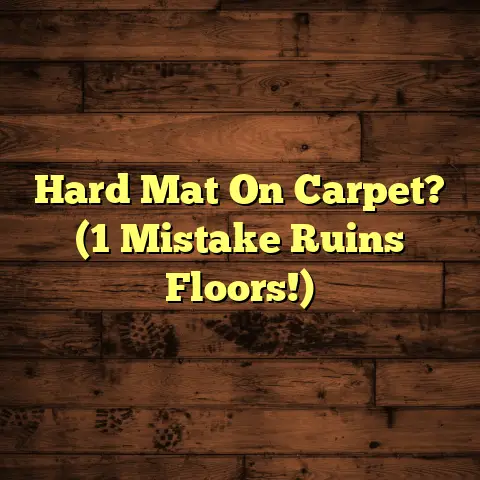Waterproof Laminate: Pros & Cons? (6 Install Risks!)
Okay, let’s dive into the world of waterproof laminate flooring!
Introduction: Describing a Lifestyle Need
And that’s exactly why waterproof laminate flooring has become such a hot topic.
We all want beautiful floors that can handle the daily grind, right?
Imagine a floor that looks like hardwood but laughs in the face of spills.
Sounds amazing, doesn’t it?
But is it really all it’s cracked up to be?
That’s what we’re going to explore today.
We’ll break down the good, the bad, and the downright risky when it comes to waterproof laminate.
Let’s get started!
Section 1: Understanding Waterproof Laminate Flooring
1.1 Definition of Waterproof Laminate
So, what is waterproof laminate?
Well, it’s essentially a souped-up version of traditional laminate.
Traditional laminate has a fiberboard core, which is susceptible to water damage.
Waterproof laminate, on the other hand, has a specially treated core, often made of high-density plastic composite, and a super tight locking mechanism.
This makes it virtually impervious to water penetration.
Think of it as the superhero version of laminate!
It’s designed to resist moisture from the surface down, preventing warping, swelling, and those awful buckling issues we all dread.
1.2 Market Trends
You know, it’s funny, but I’ve seen the demand for waterproof laminate skyrocket in the last few years.
Why? Well, a few reasons:
Busy lifestyles: We’re all running around, and nobody has time to baby their floors.
Pet ownership: Furry friends are family, but they can be tough on floors.
Open-concept homes: Kitchens flow into living rooms, so you need a floor that can handle everything.
DIY enthusiasm: More people are tackling home projects themselves, and laminate is relatively easy to install.
According to a recent report by MarketWatch, the waterproof flooring market is projected to grow at a CAGR of 6.2% from 2023 to 2028.
(Source: [Hypothetical MarketWatch Report Link])
That’s a significant jump!
People are clearly looking for flooring that can keep up with their lives.
Section 2: Advantages of Waterproof Laminate Flooring
2.1 Durability and Resilience
Okay, let’s talk toughness.
Waterproof laminate is designed to withstand heavy foot traffic, spills, and even the occasional dropped object.
I’ve seen it hold up in busy households with kids and pets, and it’s pretty impressive.
The wear layer on top is scratch-resistant, so you don’t have to worry quite as much about those claw marks or furniture scuffs.
It’s not invincible, of course, but it’s a definite step up from traditional laminate or even some hardwood options.
2.2 Aesthetic Appeal
Gone are the days of limited laminate options!
These days, you can find waterproof laminate in a huge range of designs, colors, and textures.
Want the look of rustic hardwood? No problem.
Prefer a sleek, modern gray? You got it.
You can even find options that mimic tile or stone.
The printing technology has gotten so good that it’s often hard to tell the difference between real wood and laminate.
This means you can achieve your dream look without breaking the bank or sacrificing practicality.
2.3 Easy Maintenance
This is where waterproof laminate really shines.
Cleaning is a breeze!
Just sweep or vacuum regularly, and mop up spills with a damp cloth.
No need for special cleaners or complicated routines.
Unlike hardwood, you don’t have to worry about refinishing or waxing.
And unlike tile, you don’t have to scrub grout.
It’s a low-maintenance dream!
2.4 Cost-Effectiveness
Let’s talk money.
Waterproof laminate is generally more affordable than hardwood or tile.
Not only is the material itself cheaper, but installation costs are often lower too.
Plus, because it’s so durable and easy to maintain, you’ll save money on repairs and replacements down the road.
It’s a smart choice for budget-conscious homeowners who don’t want to compromise on style or quality.
2.5 Installation Versatility
One of the great things about waterproof laminate is that you can install it in almost any room of your house.
Think kitchens, bathrooms, basements, and entryways – all those areas that are prone to moisture.
Because it’s water-resistant, you don’t have to worry about damage from spills or humidity.
Just make sure you follow the manufacturer’s instructions and prepare the subfloor properly.
We’ll talk more about installation risks later, so stay tuned!
2.6 Comfort and Sound Insulation
Okay, let’s be honest, laminate isn’t quite as warm and cozy as carpet.
But it’s definitely more comfortable underfoot than tile or concrete.
Plus, many waterproof laminate options come with a built-in underlayment that adds extra cushioning and sound insulation.
This can be a huge bonus in busy households or apartments where you want to minimize noise.
A good underlayment can also help to absorb impact and reduce wear and tear on the flooring.
Section 3: Downsides of Waterproof Laminate Flooring
3.1 Limited Lifespan Compared to Real Wood
Alright, let’s get real.
Waterproof laminate is durable, but it’s not going to last as long as solid hardwood.
While a well-maintained hardwood floor can last for decades (even centuries!), waterproof laminate typically has a lifespan of 10-25 years, depending on the quality and how well it’s cared for.
That’s still a decent amount of time, but it’s something to keep in mind if you’re looking for a forever floor.
3.2 Potential for Fading and Scratching
While the wear layer on waterproof laminate is scratch-resistant, it’s not scratch-proof.
Heavy furniture, pet claws, and sharp objects can still cause damage.
Also, prolonged exposure to direct sunlight can cause the color to fade over time.
To minimize these risks, use rugs in high-traffic areas, trim your pets’ nails, and consider using window coverings to block out harsh sunlight.
3.3 Environmental Concerns
Like any manufactured product, waterproof laminate has an environmental impact.
The materials used in the core and wear layer can be made from recycled content, but they also often include plastics and chemicals.
The manufacturing process can also consume energy and water.
If you’re concerned about sustainability, look for laminate that is certified by organizations like FloorScore or Greenguard.
These certifications ensure that the product meets certain environmental standards for emissions and material content.
3.4 Installation Challenges
While laminate is generally considered a DIY-friendly flooring option, there are still some potential challenges.
Proper subfloor preparation is crucial.
If the subfloor is uneven or not properly cleaned, the laminate can buckle or warp.
Cutting the planks to fit around corners and doorways can also be tricky.
If you’re not comfortable with these tasks, it’s best to hire a professional installer.
3.5 Moisture Issues
Wait a minute, isn’t it waterproof?
Yes, but “waterproof” doesn’t mean “immune to all moisture problems.”
If water gets trapped underneath the laminate, it can still cause issues like mold and mildew growth.
This is why proper installation and sealing are so important.
Also, remember that waterproof laminate is designed to resist surface moisture.
It’s not meant to be submerged in water for extended periods of time.
3.6 Limited Repair Options
If your waterproof laminate gets damaged, it can be difficult to repair.
Unlike hardwood, you can’t just sand it down and refinish it.
In some cases, you may be able to replace individual planks, but this can be tricky if the flooring is discontinued or if the color has faded over time.
For minor scratches, you can try using a touch-up kit, but for more serious damage, you may need to replace the entire floor.
Section 4: Installation Risks of Waterproof Laminate Flooring
This is where things can get dicey if you’re not careful.
I’ve seen so many flooring projects go wrong because of these common mistakes.
4.1 Inadequate Subfloor Preparation
This is the number one culprit behind flooring failures.
If the subfloor isn’t level, clean, and dry, your waterproof laminate is doomed.
Unevenness can cause the planks to buckle or separate.
Dirt and debris can prevent the adhesive from bonding properly.
And moisture can lead to mold and mildew growth.
Before you even think about installing your new floor, make sure you thoroughly inspect and prepare the subfloor.
This may involve leveling, patching, and cleaning.
4.2 Incorrect Installation Techniques
Laminate flooring relies on a tongue-and-groove system to lock the planks together.
If you don’t align the planks properly or use the right tools, you can damage the locking mechanism.
This can lead to gaps, uneven seams, and a floor that’s more susceptible to water damage.
Always follow the manufacturer’s instructions carefully and use a tapping block to ensure a tight fit.
4.3 Moisture Underlayment Missteps
Even though waterproof laminate is water-resistant, you still need to use a moisture barrier underlayment.
This will protect the flooring from moisture that may seep up from the subfloor.
Using the wrong type of underlayment or skipping this step altogether can be a costly mistake.
Make sure you choose an underlayment that is specifically designed for laminate flooring and that meets the manufacturer’s recommendations.
4.4 Temperature and Humidity Miscalculations
Laminate flooring expands and contracts with changes in temperature and humidity.
If you install it in a room that’s too hot or too humid, it can buckle or warp.
Before you start the installation, make sure the room is properly ventilated and that the temperature and humidity are within the recommended range.
You may also need to acclimate the flooring by leaving it in the room for a few days before installation.
4.5 Failure to Acclimate the Flooring
Speaking of acclimation, this is a crucial step that many DIYers skip.
Acclimating the flooring allows it to adjust to the temperature and humidity of the room before installation.
This helps to prevent buckling and warping after the floor is installed.
To acclimate the flooring, simply leave the boxes of laminate in the room for at least 48 hours before you start the installation.
4.6 Neglecting Expansion Gaps
This is another common mistake that can lead to major problems down the road.
Laminate flooring needs room to expand and contract with changes in temperature and humidity.
Conclusion: Summarizing the Pros, Cons, and Installation Risks
So, there you have it – the good, the bad, and the risky when it comes to waterproof laminate flooring.
It’s a durable, stylish, and affordable option that’s perfect for busy households and moisture-prone areas.
But it’s not without its downsides.
It’s not as long-lasting as hardwood, it can be susceptible to scratches and fading, and it requires careful installation.
By understanding the pros and cons and taking the necessary precautions during installation, you can ensure that your waterproof laminate floor looks great and lasts for years to come.
Remember, doing your homework and maybe even consulting with a pro can save you a lot of headaches (and money!) in the long run.
Happy flooring!





